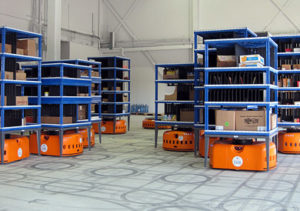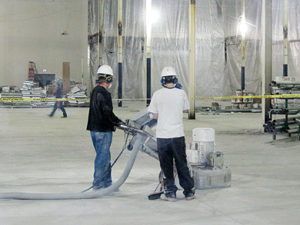When progressive companies need to automate material handling at their distribution centers, they call Kiva Systems. And when Kiva Systems needed larger facilities to accommodate their rapid growth, they turned to Chapman.
companies need to automate material handling at their distribution centers, they call Kiva Systems. And when Kiva Systems needed larger facilities to accommodate their rapid growth, they turned to Chapman.
Kiva Systems was founded in 2003 with a mission to revolutionize material handling processes for commercial distribution centers. Today, Kiva’s third-generation autonomous mobile robots are dramatically improving the productivity and accuracy of order fulfillment at many of today’s most recognizable retailers, including Office Depot, Gap, Crate & Barrel, Staples, and Boston Scientific. In 2009, Kiva Systems was one of the fastest growing companies in the US, prompting them to plan a relocation into an expanded facility in North Reading, MA.
Building out the new 150,000 sf space posed several challenges for the construction team, not the least of which was maintaining Indoor Air Quality. The new layout included roughly 50,000 sf of office space and 100,000 sf of warehouse and demonstration space, which required demolition of the entire interior footprint and the removal of the existing epoxy coating on all concrete floors. The demolition scope necessitated the use of skid steer loaders and forklifts inside the building as well as acetylene torches, diamond grinders, and cutting equipment, all of which would generate significant dust and particulates.
Chapman’s standard operating procedures include a comprehensive Indoor Air Quality Management Program that is in effect on all jobsites. Chapman’s IAQ Program laid the groundwork for addressing the high levels of particulates that would be generated at Kiva, but this job’s unique hazards called for additional, specialized measures and monitoring.
To minimize the generation of contaminants, all fuel-burning equipment was equipped with exhaust scrubbers, and all grinders, sanders, and saws were supplied with HEPA filter vacuum attachments. To minimize the migration of contaminants, active work areas were segregated with enhanced temporary protection and housekeeping activities were expanded. Temporary exhaust was achieved by removing windows, installing negative air pressure fans and air scrubbers, and strategic use of the rooftop ventilation equipment.
 To verify the results of these efforts, CO2 monitors were installed throughout and monitored continuously and airborne particulate testing was performed at regular intervals. These combined efforts resulted in a healthy environment for construction workers and the building’s future occupants.
To verify the results of these efforts, CO2 monitors were installed throughout and monitored continuously and airborne particulate testing was performed at regular intervals. These combined efforts resulted in a healthy environment for construction workers and the building’s future occupants.
Chapman’s Kiva Systems team includes Vice President Rich Elliott, Project Manager John Twomey, Assistant PM Rob Lowre, Supervisors Joe Lepore and Bob Delano and Assistant Supers John Davis and Ryan Trott. The project is scheduled to be complete in April.


